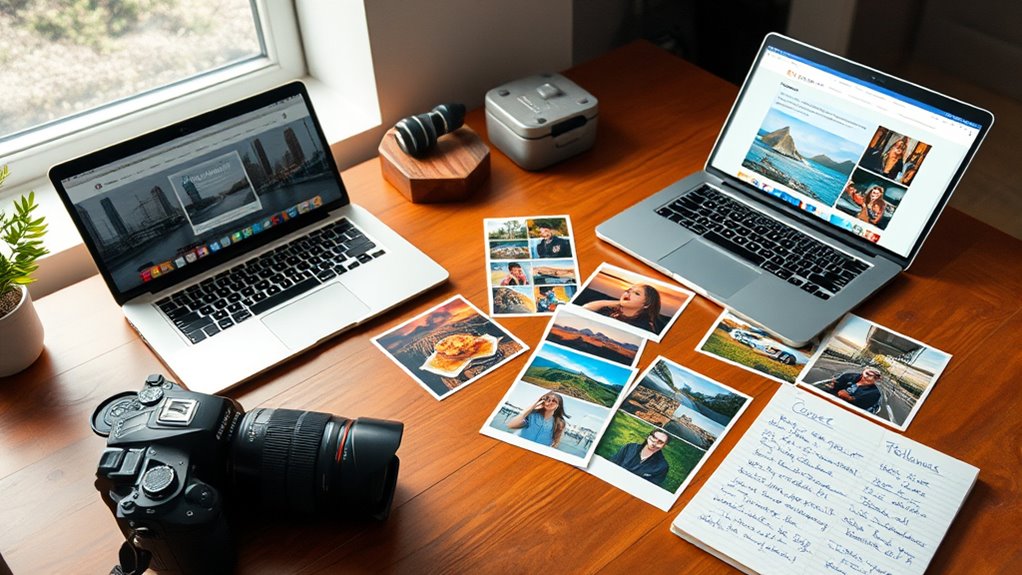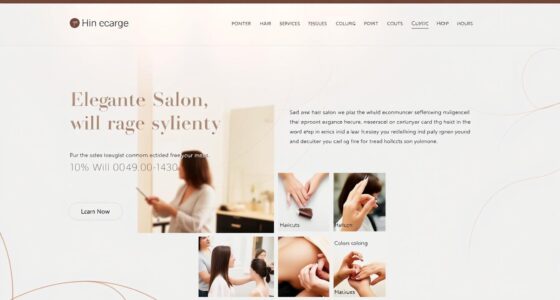Even without a big following, you can license your photos to brands by building a strong, targeted portfolio that showcases your unique style. Focus on understanding licensing agreements, clearly defining usage rights, scope, and duration to protect your work. Establish professional relationships by being transparent and offering high-quality, authentic images. With solid contracts and a professional approach, you can attract brand interest and succeed in licensing. Keep exploring to discover more tips and strategies for growing your licensing opportunities.
Key Takeaways
- Develop a professional, targeted portfolio showcasing your best work tailored to brand needs.
- Identify niche markets and small brands that value quality over large followings.
- Use licensing agreements and model releases to protect your work and clarify usage rights.
- Build relationships through transparency, professionalism, and consistent delivery of high-quality images.
- Leverage online platforms and direct outreach to connect with brands seeking authentic, fresh content.

Have you ever wondered how photographers turn their images into a steady income stream? The truth is, licensing your photos to brands is a powerful way to do just that, even if you don’t have a massive following. The key is understanding how to approach brands professionally and protect yourself with the right legal tools. One of the most important elements in this process is having clear model contracts and licensing agreements. These documents serve as the foundation for your business relationships, ensuring everyone is on the same page about usage rights, compensation, and restrictions.
When you’re ready to license your photos, start by preparing your portfolio. Focus on showcasing images that are versatile and appealing to brands in your target market. Once you identify potential clients, reach out with a concise pitch—highlight your unique style and how your images can help their brand stand out. But before sending your photos, make sure you’re prepared with solid licensing agreements. These agreements specify exactly how the brand can use your images, whether for advertising, social media, or product packaging. They also define the scope of use, duration, and any exclusivity terms. Having a well-drafted licensing agreement protects your rights and ensures you’re fairly compensated, preventing any misunderstandings down the line.
Prepare a strong portfolio and clear licensing agreements to protect your work and attract brand collaborations.
Many photographers overlook the importance of model contracts, especially when their images feature recognizable people or private property. If your photos include models, it’s essential to have them sign model releases beforehand. These contracts grant you permission to use the images commercially and clarify that the models waive any rights to future claims. Without signed model contracts, you might face legal issues or restrictions on licensing your photos to brands. It’s a straightforward step that saves you headaches and potential legal battles later. Additionally, understanding the vetted products available for newborns can help you tailor your offerings to meet safety and quality standards, which can be a selling point when working with brands.
As you build relationships with brands, always emphasize transparency. Clearly explain your licensing terms and be open to negotiations. Remember, even without a large following, brands value high-quality, authentic images. Your professionalism in preparing model contracts and licensing agreements demonstrates your commitment to protecting both your work and your clients’ interests. Over time, as you gain more licensing experience and positive feedback, your reputation grows. This can lead to repeat business and referrals, gradually expanding your reach. The key is to approach each deal with clarity and confidence, knowing that proper legal groundwork will keep your licensing process smooth, fair, and profitable.
Frequently Asked Questions
How Do I Approach Brands for Licensing Opportunities?
When approaching brands for licensing opportunities, focus on showcasing your unique style and portfolio. Reach out with a professional pitch that highlights your potential for model partnerships and branding collaborations. Be proactive, personalize your message, and demonstrate how your images can add value to their campaigns. Even with a smaller following, your quality work can attract brands enthusiastic for authentic, fresh content. Persistence and professionalism are key to building these valuable connections.
What Legal Considerations Should I Be Aware Of?
Did you know that around 85% of licensing disputes involve intellectual property issues? When licensing your photos, you need to review model contracts carefully to guarantee you have the rights to use all included elements. Protect your work by understanding intellectual property laws, and always get written agreements from brands. Being aware of these legal considerations helps you avoid costly legal trouble and ensures your rights are secure.
How Do I Price My Photos for Licensing?
To price your photos, start with solid pricing strategies by researching the market to see what others charge for similar images. Consider the usage rights, exclusivity, and image quality, then set a fair rate that reflects your skill level and effort. Don’t forget to track industry trends and adjust your prices accordingly, ensuring you’re competitive yet fairly compensated for your work.
Can I License Personal or Copyrighted Images?
Think of licensing your images like sharing a secret with a friend—you have to be sure you’re allowed to share it. Yes, you can license personal or copyrighted images, but you need to understand image copyrights and licensing basics first. Make sure you own the rights or have permission before licensing, so you’re not infringing on someone else’s rights. This way, you protect your work and avoid legal issues.
What Types of Licensing Agreements Are Available?
You have several licensing agreement options, each with specific usage rights and licensing terms. A royalty-free license lets you sell images multiple times without extra fees, while rights-managed licenses specify how, where, and for how long images can be used. Exclusive licenses give a brand sole usage rights. Carefully review licensing terms to make certain they match your expectations, protecting your rights and controlling how your photos are used.
Conclusion
Think of your photos as seeds waiting to bloom in a brand’s garden. Even if your following is small, your unique perspective is a rare bloom that brands crave. When you license your images, you’re planting your creative spirit into new fields, nurturing growth beyond numbers. So, keep sowing your talent, stay persistent, and watch how your visual stories flourish in unexpected places—your work is the key to uncovering endless possibilities.









